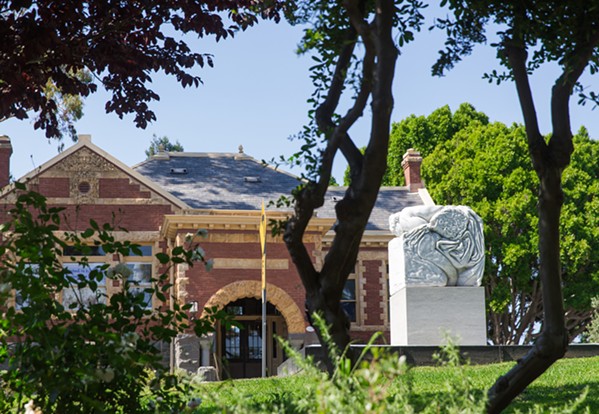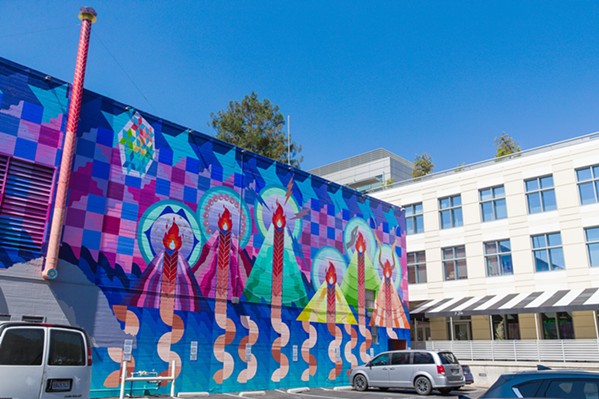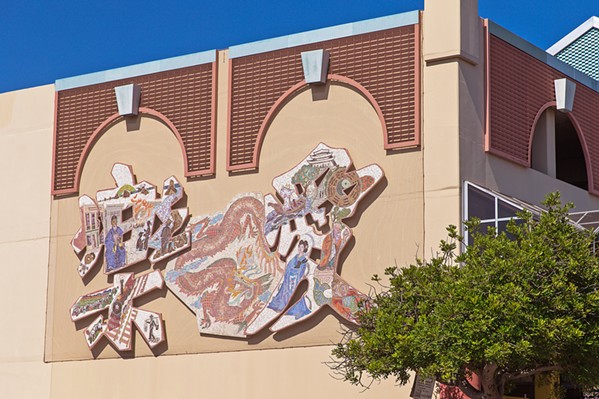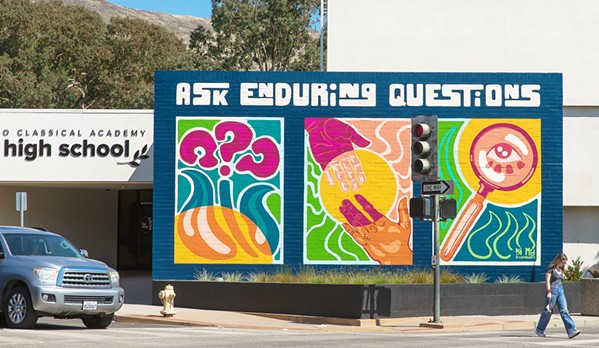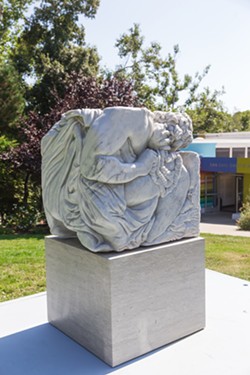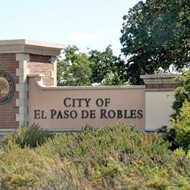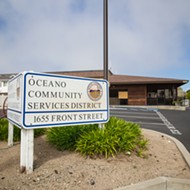Creative culture: Both local artists and outside influences inspire the range of public art in San Luis Obispo
By Adrian Vincent Rosas[
{
"name": "Newsletter Promo",
"id": "NewsletterPromo",
"class": "inlineCenter",
"insertPoint": "4",
"component": "15264767",
"requiredCountToDisplay": "0"
},
{
"name": "Ad - Medium Rectangle CC01 - 300x250 - Inline Content",
"class": "inlineCenter",
"insertPoint": "8",
"component": "15582119",
"requiredCountToDisplay": "12"
},{
"name": "Ad - Medium Rectangle LC01 - 300x250 - Inline Content",
"class": "inlineCenter",
"insertPoint": "18",
"component": "15582122",
"requiredCountToDisplay": "22"
},{
"name": "Ad - Medium Rectangle 9 - 300x250 - Inline Content",
"class": "inlineCenter",
"insertPoint": "28",
"component": "15582121",
"requiredCountToDisplay": "32"
}]
To some, public art is a subtle touch that enhances a city's culture, adding vibrancy to even the blandest buildings and offering artists the biggest forums to showcase their works.
To others, it's an eyesore, a waste of public funds and time, and a reminder that the city is often more concerned about tourism than its residents.
But to many in San Luis Obispo, public art is a journey, a step-by-step quest that enhances not only the strength of the city's unique qualities but also helps the community heal and grow closer.
So let's take a stroll. That's Leann Standish's plan whenever a visitor comes into San Luis Obispo.
"I've been doing tours of public art in the city for a few years now, sometimes for visitors, other times for journalists, and even other times professional artists," Standish said.
The executive director of the San Luis Obispo Museum of Art (SLOMA) starts the journey with Seven Sisters (Celestial Subduction)—a massive mural on the back of the Fremont Theater by artist Maria Molteni that greets visitors entering downtown.
"This is usually where all the selfies happen," she said laughing. "From here depending on the time of day, we either go across the street to Black Horse for some coffee or Saints Barrel for a nice glass of wine."
After the brief sojourn, Standish takes her fellow art adventurers to Cheng Park—a quaint garden inspired by Chinese culture on the corner of Marsh and Santa Rosa.
"The features in this garden are emblematic of the outside influence you can find in a fair amount of public art in the city," she said.
Standish guides her guests past the vividly colored utility boxes along Marsh toward Scout Coffee where the next piece can be found. Eternal Blossom—a giant mural by art collective Canned Pineapple located on the side of the building—is one of Standish's favorite pieces to show to incoming visitors.
"It's a nice little gem on Garden Street that most people walk past every day, so I like to point it out because of how pretty it is. ... From there," she said with a sigh, "I do reluctantly take people to see Bubblegum Alley, but then it's off to another one of my favorite spots!"
After the iconic—nay, infamous—Bubblegum Alley, she takes visitors to a place seemingly more mundane, at least at the outset: her office and the home of Leah Rosenberg's SLO(W) Rainbow.
"Going over from the alley to Broad Street and seeing the mural as you walk toward the museum is always such a vivid experience for me and my fellow art adventurers," she said.
The tour ends on the front lawn of the SLOMA building, looping back into the core of downtown, showcasing the cubic wonder of Adam Parker Smith's David sculpture.
"I love ending the tour on the front lawn of the museum because it shows just how much art there is in just two blocks of the city," she said. "There is such a range, and that's not even touching on even half of what the city has to offer."
However, she acknowledges that it can be hard to fully perceive what San Luis Obispo offers in terms of public art. It's something that she and other art activists in the community hope to change.
Understand the past
Allen Root has seen it all.
"I consider myself to be somewhat of a public art aficionado," he said with a laugh. "I am always thinking about what public art is and what people consider to fall into that category."
In 1976, Root founded a welding business specializing in custom metalwork for residences, churches, and commercial spaces. Along the way, Root and his company found themselves working on public arts-related metalwork across California.
So when Root told New Times that he had worked over the last three decades—if not more—to build the framework for public art in San Luis Obispo, he meant it both figuratively and literally.
Alongside his peers, Root helped craft the first public art ordinance in 1990, the same one that serves as the guiding principle for today's city art master plan.
Redefined in the early 2000s and then again in 2019, the San Luis Obispo Public Art Master Plan is an all-inclusive document that the city uses to define what public art is, where it can go, and the logical steps to find artists.
Although the document has served as the sole guide throughout the years, at times, according to Root, sticking to the plan is often at the whim of outside influences.
"We have worked very hard for many years to develop the public art program in SLO," he said. "But the economy in SLO had its struggles—especially during the pandemic years—and it took a bit of a back seat."
In his current role as president of SLO County Arts, one of his many "hats" within the organization, Root has seen the public art efforts in the city rise, fall, and rise again.
"Despite all of the struggles it has gone through, the framework for the program has always been there," he said.
Root stressed that the public art program would not be where it is without that spirit of cooperation and compromise that built the trust the organization and the city have in each other.
So what's the best way to continue to foster the relationship between art and the city?
Collaboration
Meghan Burger is working to find the answer to that question every day.
As the recreation manager for San Luis Obispo's Parks and Recreation Department, Burger serves as the coordinator for the public art program.
"I am a longtime resident, born and raised in SLO, and I've been working in public service for the entirety of my professional career," she said. "I do what I do because I value the building of community, especially one as diverse as ours, and public art is one way to do that."
She serves a big role in finding that understanding of what the city wants to achieve with public art and, in turn, establishing a goal for where it wants things to be in the future.
"Part of the answer to that is the conservation and maintenance of what we have as well as looking at what we can do to activate the spaces under our jurisdiction," Burger said.
While the city works with various parties, including SLO County Arts, Burger said the city's current main collaborator is SLOMA.
"It's still a new relationship in the grand scheme of things, but it has been one that has allowed the city to focus on other aspects of public art we really couldn't before," she said. "I don't know how many people realize that SLOMA is just one of the many pieces of public art."
SLOMA Executive Director Standish said that through contracting with the city over the past half-decade, she's had an opportunity to bring pieces together in ways they might not have been able to do quite as easily.
"It's been beautiful how the community has responded to our collaboration, especially with some of our early collaborations in 2021," Stanish said. "We have been able to work with people from places like the Fremont, local coffee shops, and even Woodstock's to help bring larger pieces to the city."
Thanks to the coordinated efforts of the two parties, Standish said they have not only managed to bring pieces like Seven Sisters and The Greys In-Between to life but also do more than just getting them to exist.
"Part of the reason we are a good partner for this is we can go deeper and provide community and education programs," she said. "Each project is sort of a good tool kit to bring those different things to the community."
However, Standish stressed to New Times that SLOMA was undertaking the enhancement and educational opportunities on their own accord outside of their role as a city public art contractor.
"The city doesn't pay for the expansion of those public art pieces, as it's not in their master plan," she said. "But because we consider SLOMA to have a mission as an education institution, we want to use this opportunity to provide that extra resource to the community we are tied to."
Those ties to the community, whether through education or enhancement, should ideally help everyone understand the multilayered, multifaceted approach the city has to enacting its public art master plan.
But not everyone sees things that way.
Controversy
Elizabeth Johnson has long expressed her discontent with some of the pieces that resulted from the collaboration between SLOMA and the city of SLO.
In an opinion letter submitted to New Times in January of this year, Johnson called into question the placement, artist, and overall purpose of The Greys In-Between piece by Anila Quayyum Agha.
It's one of multiple large pieces that will take center stage in roundabouts across SLO, a project coordinated by the SLOMA-city of SLO public art collaboration.
In her letter, Johnson said that she felt SLOMA Chief Curator Emma Saperstein felt the need to defend the piece with the fact that Agha is a Pakistani-born person who lives in Indiana. Johnson—who voiced her support of Agha and her previous work with Cuesta Community College—wrote that Agha's piece was not viewable to the public the way public art was meant to be seen.
She also called into question the cost of building such a project as well as the fact that Agha was not a local artist and did not take part in the crafting of the project until its unveiling.
When New Times reached out to Johnson, she chose not to elaborate on the points she made in her letter to the editor. Johnson also declined to put New Times in contact with others who might feel similarly about public art in SLO.
Johnson did say that she "might write an op-ed response to whatever you write and put it together with my research."
"Let's see what you come up with," she said. "I know you are not paid a lot for your work, but I'm not paid at all for your work, so good luck."
While she chose not to elaborate further on her stance, Johnson did provide New Times with invoices of SLOMA's spending on the project that did shine a light on some of the cost that comes with working with nonlocal artists. According to the data provided, Agha's The Greys In-Between cost around $217,000 to purchase and eventually install.
The price tag of most out-of-town installations, SLO County Arts' Root said, mainly stems from the overhead costs that come with bringing in outside artists to put together pieces for the city.
"You gotta think about travel costs for evaluations and planning, let alone the materials to bring these programs together," he said.
Root noted that bringing in an outside artist isn't always an inherently negative thing—sometimes the piece that fits best for a city like SLO requires a nonlocal artist.
"Depending on the scale and the medium, if you want a specific style or type of art, then it's good to bring someone in who can pull that off," he said.
Things aren't necessarily quick and easy either when it comes to working with someone local, Root explained.
"Sometimes I have to come in and kind of stoke that flame since there are a lot of requirements that come with working with the city that some artists don't like working with," he said with a laugh. "I have worked alongside many artists who are interested in doing public art, but the process is just too much for some people, and they don't want to deal with the paperwork."
Creativity
SLO city's Burger considers the SLOMA collaboration to be crucial to getting public art out into the city but also acknowledges that it's only one piece of the puzzle.
"The reality is that public art needs more public support to bring back the type of programs that will help it succeed long-term," Burger said. "We don't want to lose sight of our other programs in Parks and Rec either, so as we head into the future, we are currently looking for a person to serve solely as a public art coordinator,"
Burger said she has worked hard to make sure that residents know that public art is meant to bring the community together and express the creativity that makes SLO so special.
"Everyone deserves to have a voice and opportunity to feel the beauty art brings to our city, while also being proud of the place they live in," she said. "I feel like the public art here in SLO is so diverse because our community is filled with so many diverse opinions and perspectives, and that's good—the art should be representative of the people that live here."
Root is in the same boat, and he's taking steps to encourage local artists to work with the city while remaining open to out-of-town artist contributions.
"One of the things we are currently working on is an alternate program to get artists involved with local art that doesn't have all the steps of working directly with the city," Root said. "As I said before—there are a lot of artists who don't like taking part in the logistical process with all of the cost and paperwork but still want to be involved—that's why we are working on easing that process."
He has some help in bringing resources to local artists thanks to his team at SLO County Arts, including Jordan Chesnut who said that now more than ever, public art is being encouraged by the state of California for development.
Chesnut told New Times that two years ago, the legislature earmarked more than $600 million for arts in the state. The unprecedented move opened up new pathways for organizations like SLO County Arts to bring art to the general public.
Chesnut serves as the SLO County Arts director of programming. From projects like murals in public plazas to small exhibits showcasing the majestic monarch butterfly, she knows her way around public art installations.
"One of our main goals is to encourage artists to think about how their creative practice could impact the people and places they love [and in the process] further expand our perception of what public art can be," she said.
Chesnut noted that the solution to sustainable public art programs starts with the artists themselves.
"The perception of the role of artists in communities has changed nationwide throughout the pandemic," she said. "We are expecting artists and art organizations to act as voices for a whole."
So where does that leave the future of public art in SLO?
"I am optimistic ... because there is a creative spirit here and an appreciation for the arts," Chesnut said. "I believe that as long as a nonlocal [or local] artist is sensitive to the history and culture of SLO, and they are adaptive and acceptive of feedback from residents, then that is what matters." Δ
Reach Staff Writer Adrian Vincent Rosas at [email protected].
Correction: SLO County Arts wanted to clarify how much money the California legislature set aside for arts. The article was updated to show that the state has more that $600 million earmarked for arts in California.
Latest in News
Readers also liked…
-

When the levee breaks: Oceano residents, county officials walk a tightrope of regulations to manage Arroyo Grande Creek, which some say led to the levee's failure in January
May 18, 2023 -

Cal Poly report highlights offshore wind's potential to spur green energy transition
Jun 8, 2023 -
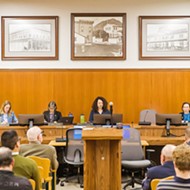
Cal Poly students demand rent control, accountability for substandard housing from SLO City Council
Jun 22, 2023

